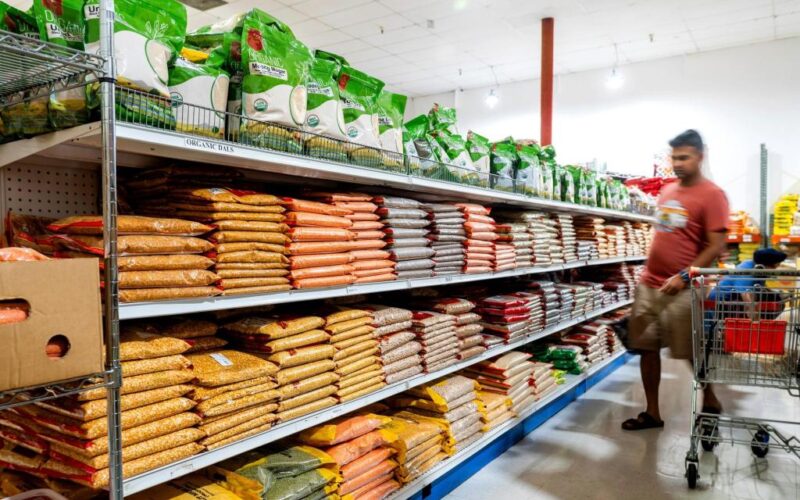By JOSH BOAK, Associated Press
WASHINGTON (AP) — President Donald Trump began imposing higher import taxes on dozens of countries Thursday just as the economic fallout of his monthslong tariff threats has begun to cause visible damage to the U.S. economy.
Just after midnight, goods from more than 60 countries and the European Union became subject to tariff rates of 10% or higher. Products from the EU, Japan and South Korea are taxed at 15%, while imports from Taiwan, Vietnam and Bangladesh are taxed at 20%. Trump also expects the EU, Japan and South Korea to invest hundreds of billions of dollars in the United States.
“I think the growth is going to be unprecedented,” Trump said Wednesday. He said the U.S. was “taking in hundreds of billions of dollars in tariffs,” but did not provide a specific figure for revenues because “we don’t even know what the final number is” regarding the rates.
Despite the uncertainty, the White House is confident that the onset of his tariffs will provide clarity about the path for the world’s largest economy. Now that companies understand the direction the U.S. is headed, the Republican administration believes it can ramp up new investments and jump-start hiring in ways that can rebalance America as a manufacturing power.
So far, however, there are signs of self-inflicted wounds to the U.S. as companies and consumers brace for the impact of the new taxes.
Risk of economic erosion
Hiring began to stall, inflationary pressures crept upward and home values in key markets started to decline after the initial tariff rollout in April, said John Silvia, CEO of Dynamic Economic Strategy.

“A less productive economy requires fewer workers,” Silvia said. “But there is more, the higher tariff prices lower workers’ real wages. The economy has become less productive, and firms cannot pay the same real wages as before. Actions have consequences.”
Many economists say the risk is that the American economy is steadily eroded.
“It’s going to be fine sand in the gears and slow things down,” said Brad Jensen, a professor at Georgetown University.
Trump has promoted the tariffs as a way to reduce America’s persistent trade deficit. But importers tried to avoid the taxes by bringing in more goods before the tariffs took effect. As a result, the $582.7 billion trade imbalance for the first half of the year was 38% higher than in 2024. Total construction spending has dropped 2.9% over the past year.
The economic pain is not confined to the U.S.
Germany, which sends 10% of its exports to the U.S. market, saw industrial production sag 1.9% in June as Trump’s earlier rounds of tariffs took hold. “The new tariffs will clearly weigh on economic growth,” said Carsten Brzeski, global chief of macro for ING bank.
Dismay in India and Switzerland
The lead-up to Thursday fit the slapdash nature of Trump’s tariffs, which have been rolled out, walked back, delayed, increased, imposed by letter and renegotiated.
Trump on Wednesday announced additional 25% tariffs to be imposed on India because of its purchases of Russian oil, bringing its total import taxes to 50%.
A leading group of Indian exporters said that will affect nearly 55% of the country’s outbound shipments to America and force exporters to lose long-standing clients.
“Absorbing this sudden cost escalation is simply not viable. Margins are already thin,” S.C. Ralhan, president of the Federation of Indian Export Organizations, said in a statement.
The Swiss executive branch, the Federal Council, was expected to meet Thursday after President Karin Keller-Sutter and other Swiss officials returned from a hastily arranged trip to Washington in a failed bid to avert a 39% U.S. tariffs on Swiss goods.
Import taxes are still coming on pharmaceutical drugs, and Trump announced 100% tariffs on computer chips. That could leave the U.S. economy in a place of suspended animation as it awaits the impact.
Stock market remains solid
The president’s use of a 1977 law to declare an economic emergency to impose the tariffs is under a legal challenge. Even people who worked with Trump during his first term are skeptical, such as Paul Ryan, the Wisconsin Republican who was House speaker.
“There’s no sort of rationale for this other than the president wanting to raise tariffs based upon his whims, his opinions,” Ryan told CNBC on Wednesday.
Trump is aware of the risk that courts could overturn his tariffs. In a Truth Social tweet, he said, “THE ONLY THING THAT CAN STOP AMERICA’S GREATNESS WOULD BE A RADICAL LEFT COURT THAT WANTS TO SEE OUR COUNTRY FAIL!”
The stock market has been solid during the tariff drama, with the S&P 500 index climbing more than 25% from its April low. The market’s rebound and the income tax cuts in Trump’s tax and spending measure signed into law on July 4 have given the White House confidence that economic growth is bound to accelerate in the coming months.
Global financial markets took the new tariffs in stride, with Asian and European shares and U.S. futures mostly higher.
But ING’s Brzeski warned: “While financial markets seem to have grown numb to tariff announcements, let’s not forget that their adverse effects on economies will gradually unfold over time.”
Trump foresees an economic boom. American voters and the rest of the world wait, nervously.
“There’s one person who can afford to be cavalier about the uncertainty that he’s creating, and that’s Donald Trump,” said Rachel West, a senior fellow at The Century Foundation who worked in the Biden White House on labor policy. “The rest of Americans are already paying the price for that uncertainty.”
Originally Published:








